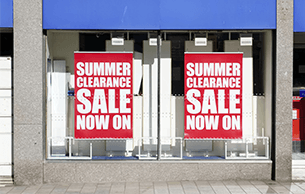
• Over 41% of those under the age of 40 prefer to shop online, rather than in-store
• British consumers want access to payment methods that aren’t yet available, such as fingerprint scan (26%), retina scan (16%) and embedded microchips (9%)
• Twitter data shows British consumers express frustrations with the in-store experience most prominently in the weeks leading up to Christmas[i]
London – 23rd July 2019: Paymentsense, Europe’s largest merchant services provider, today released new findings on the waning level of consumer patience in Britain. In partnership with YouGov [ii] BrandIndex, the only daily consumer perception research service of brands, Paymentsense found that 37% of Gen Z’s (respondents aged 16-24) agreed that access to online shopping has made them more impatient while shopping in store for retail purchases. Furthermore, 41% of those aged under 40 prefer to shop online rather than in-store, those respondents claiming it is due to a combination of convenience (81%) , cost (63%), there being no queues (64%) and choice (61%).
This new data from Paymentsense highlights the necessity of UK high-street brands to transform their businesses and embrace digital technology. The British consumer is becoming more impatient with long queues, lack of choice and higher costs, resulting in them choosing to shop for retail products from the comfort of their own homes.
Further to the typical causes of impatience, the findings highlight a growing desire for alternative, more efficient methods of payment. In 2017, card payments overtook cash as the most frequently used payment method in the UK. However, today’s findings show over 31% of British consumers would prefer to use methods of payment that are currently only seen in sci-fi films rather than reality. These include fingerprint scanning (26%), retina scanning (16%), and embedded microchip payments (9%). 12% of British consumers said that a wider variety of payment methods like these would improve their in-store shopping experience.
“Retailers operate in an experience economy. Consumers expect, and now demand, a first-class level of service when they enter a store and will leave and not return if they have had a bad experience,” said Guy Moreve, Chief Marketing Officer at Paymentsense, “The in-store experience starts the moment a consumer sets eyes on the store front, and their last interaction before they leave is paying for any goods or services. A long queue, a faulty payment device, or a ‘cash-only’ sign not only frustrates consumers but will stop them from returning. This data showcases these continued customer frustrations. It is imperative businesses react and ensure they’re delivering the complete service demand by their customers. Failure to do so will hinder their growth and continued success.”
Following the analysis of more than 24,000 tweets over the last 12 months, the most impatient time for in-store purchases was the week prior to the 25th December and the impending holiday period, with a 300% spike in tweets expressing consumer frustrations. However, for online purchases there was no significant peak throughout the year. This would imply consumers find the online shopping experience less frustrating than in-store and validates the findings of the survey, with the need for retailers to review in-store operations.
Although technology may be a cause of the rising level of impatience, it also looks to be the solution. As 46% of Gen Z feel smart technology within the store environment would improve their experience. This includes using a mobile device to locate products in-store to remove the need to ‘go hunting’ for products themselves.
Paymentsense: Rising levels of British impatience – Key Findings
Alternative methods of payment
Payments are constantly transforming. From traditional cash purchases, to the nowadays more popular contactless payments. The report corroborated previous findings that card payments continue to be the most popular method, although alternative methods are on the rise:
• 78% of consumers consider the use of chip and pin
• 75% of consumers would consider paying with cash. With 79% of over 55’s considering this method of payment
• Contactless payments are close behind with 72% currently considering the use of this method
• 26% of consumers would consider using fingerprint scans
• 16% of consumers would consider using their retina as a payment identifier
• 9% of consumers would consider an embedded payment microchip as a method of payment
Flexible payment policies a differentiator for Gen Z
Flexibility in payments is a key consideration when undertaking significant retail purchases. Often this is easier to obtain online as all the necessary forms and paperwork can be completed and processed in a central location. The findings validate this and showcase the significant difference in disposable incomes between Gen Z’s and the over 55’s.
• 52% of Gen Z (16-24 year olds) who prefer online shopping say it is because it provides them with more flexibility regarding the time of payment
• Compared to only 26% of over 55’s who prefer online shopping
Rising levels of technology causing those under 25 to become more impatient
When asked to what extent, if at all, do you agree with the statement; “Access to online shopping has made me more impatient while shopping in-store for retail purchases”, 37% of those aged under 24 strongly agreed or agreed with the statement. Whereas, only 17% of the older generation, aged 55 and over, strongly agreed or agreed.
What improvements would reduce levels of impatience in the in-store environment
Although the UK is infamous for queuing, the data showed that British consumers would welcome shorter queues within stores. This was the most popular improvement chosen by respondents, with over half of all respondents (52%) stating this would improve the in-store environment. Other key findings are:
• On average, 33% of British consumers would welcome more self-service checkout machines
• Nearly a third of respondents would welcome smart technology solutions to help alleviate the inability to find physical products (32%)
• A quarter of respondents would welcome a hybrid in-store/online experience whereby a customer can purchase online immediately, while in-store (25%).


























